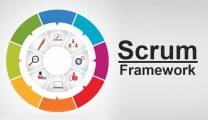What is a resource management solution?
A resource management solution is a software tool that helps plan, allocate, and manage a company’s resources involved in projects. It contributes to their efficient utilization for timely and successful completion of all projects running in the organization as well as improving business outcomes.
This becomes possible thanks to the diverse functionality of such tools – from providing resource managers with necessary resource-related data to making forecasts and planning resources for future projects. Some solutions embrace both project and resource management functionality and in doing so make it super easy to manage all project-related processes.
Resource management software shouldn’t be confused with enterprise resource planning systems; these solutions aim to integrate and automate fundamental business processes – project and resource management, risk management, finance, supply chain, procurement, CRM, and more. Their main goal is facilitating achieving business goals by optimizing an organization’s daily business activities.

What is the difference between project and resource management software?
As a rule, project management solutions have the following capabilities:
- Task management;
- Project scheduling;
- Collaboration tools;
- Tracking project progress;
- Time tracking;
- Budget management;
- Automatic report generation.
When you manage one project with a predictable workflow, the above-mentioned functionality can work quite well. But let’s examine the cases when traditional PM software isn’t enough.
- A company runs multiple concurrent projects with a shared pool of resources.
- You need to bring globally distributed teams together.
- It’s difficult to keep track of all essential resource-related data, and/or its amount is too large.
- You need to plan resources for upcoming projects.
In the above-mentioned situations, it’s critically important to effectively plan, allocate, and manage resources involved in projects; and this is where a resource management tool can assist you. Let’s examine its functionality in more detail.
What are the essential resource management capabilities?
Providing visibility of resource-related data
Typically, resource management tools keep, organize, and help manage all the data required for a variety of resource management processes: team members’ skills and their levels, capacity, availability, location, involvement in projects, performance data, etc.
.png)
Smart resource allocation
The software helps allocate resources based on their skills, capacity, and availability. More sophisticated solutions have functionality that automatically picks up a team member who is a perfect match for completing a project task.
Forecasting resource groups’ capacity and workload
RM solutions can forecast the output you can expect from your teams and their future workload as well as predict bottlenecks to prevent further difficulties in the workflow.
Providing insight into resource performance
You can gain insight into resources’ productivity, track spent vs remaining hours, and get an insight into how well the team members cope with their work.
Identifying sources of issues
Some RM tools help identify which of the resource groups have become a bottleneck, when, and why.
Performing scenario analysis
With this functionality, you can try out different ways of predicting and resolving bottlenecks and test other management decisions as well as analyze the effect of changes on the workflow.












Replies to This Discussion